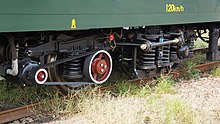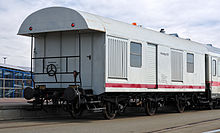Generator car

Generator cars are railway cars that are placed in passenger trains to ensure their energy supply.
function
On many railways, passenger coaches are supplied with electrical energy by the locomotive via a train busbar . If that is not possible, especially if the locomotive cannot supply enough energy or does not have a train busbar, a generator car is placed on the train. There a diesel engine runs exclusively to run an electrical generator that generates electrical energy for the cars . This system is mainly used in non-electrified railways and trains that consume a lot of energy, such as air conditioning .
A special form of the generator car is designed so that an electric traction vehicle can be supplied with power. Overall, this is a diesel-electric traction vehicle whose systems are distributed over two vehicles. This form is used when electric traction vehicles are to be retrofitted for operation on non-electrified routes (see examples below Dortmund and RTM) or because axle load and profile restrictions suggest a division (e.g. on the Diakopto – Kalavryta railway line ).
Europe
Germany
The Tegernsee-Bahn had a generator car in use until the passenger transport was taken over by the Bavarian Oberlandbahn .
Generator cars are also widespread on museum and tourist railways, which often use former or current freight locomotives for their trains (which have no power supply for the train busbar) or have retrofitted electrical systems in historical vehicles that cannot be supplied by the locomotive.
The museum trams of the local transport museum in Dortmund are supplied with electricity by generator cars because they run on a non-electrified route.
Since the use of air-conditioned through cars by the North German Railway Company (neg), a generator car has been in use on its Niebüll – Dagebüll route since 2008, as the existing railcars do not generate enough electrical power. This vehicle , converted from a freight car , was previously used by the AKN Railway to supply power to military transport trains, because the locomotives used there could not supply the passenger cars in such trains. For the same purpose, the East Hanoverian Railways had three generator cars since 1985. One was converted from a two-axle mail car, the other two from a three-axle conversion car . One has since been scrapped, the other was given to the neg in 2012 . The third car is still with the OHE in 2013.
The Railroad Development Corporation Germany (RDCD) intends to use generator cars in their trains in the Sylt shuttle traffic, which will supply their trains with energy and compressed air and serve as a lounge for the train attendants . The two-axle wagons are called Uks. They were converted from energy supply cars from aid trains of the Deutsche Reichsbahn in the GDR.
Austria
The control cars of the double-decker trains of the Graz-Köflacher Bahn are equipped with a diesel generator, since the GKB diesel locomotives are not equipped with train power supply . For special trains , GKB operates two-axle generator cars that have been converted from accompanying cars and are also used together with double-deck cars if a control car fails.
The Stainzerbahn's bottle train , which is pulled by a steam locomotive, has a generator car. This is mainly needed for the Schilcherschaukel buffet car and the rarely used interior lighting.
France
The SNCF used generator wagons e.g. B. in the TEE Mistral or the TEE Aquitaine . The air conditioning systems of the INOX DEV wagons , INOX TEE wagons and Grand Confort wagons of these trains require three-phase alternating current 380 V / 50 Hz , this type of current was not provided by locomotives and multi-system equipment for supplying direct current or single-phase alternating current of different voltages and network frequency in the various European networks was considered too complex at the time, so these cars require a generator car to operate. The elaborate energy supply led to these wagons being parked in the 1990s , whereas the Corail wagons, some of which are only a few years younger , are supplied with energy from the locomotive via static converters and are still in operation today.
Greece

On the Diakopto – Kalavryta railway line in Greece , generator wagons were even used until recently to generate the operating current for the electric multiple units.
Italy
The FS put generator trucks z. B. in the TEE Mediolanum .
Netherlands
The RTM M 17 diesel-electric multiple unit in the Netherlands is also supplied with power by a generator car running in the middle.
Norway
Generator trucks are still in use in Norway today.
Hungary
The Hungarian railway MÁV uses its generator cars when passenger trains are hauled by diesel locomotives of the M62 series that do not have their own train heating system.
America
Most diesel locomotives built specifically for passenger transport in North America are equipped with a generator to power the passenger coaches. In some cases, however, older diesel locomotives were also converted into control cars for push-pull operation in urban traffic. These control cars received a diesel engine with a generator to supply the cars; but the generator could be dispensed with on the train locomotive.
Asia
No mainline locomotive in Israel has a heating generator. All locomotive-hauled passenger trains run with generator cars all year round because of the air conditioning . Generator cars are also common in Indian long-distance trains with air-conditioned cars and diesel-powered vehicles.
Australia
Generator cars are common on long-distance trains in Australia , for example in the Indian Pacific , The Ghan or The Overland .
See also
Individual evidence
- ↑ stm / oblique: The new Sylt traffic from DB and RDC Germany . In: Eisenbahn-Revue International 2/2016, p. 96f.



